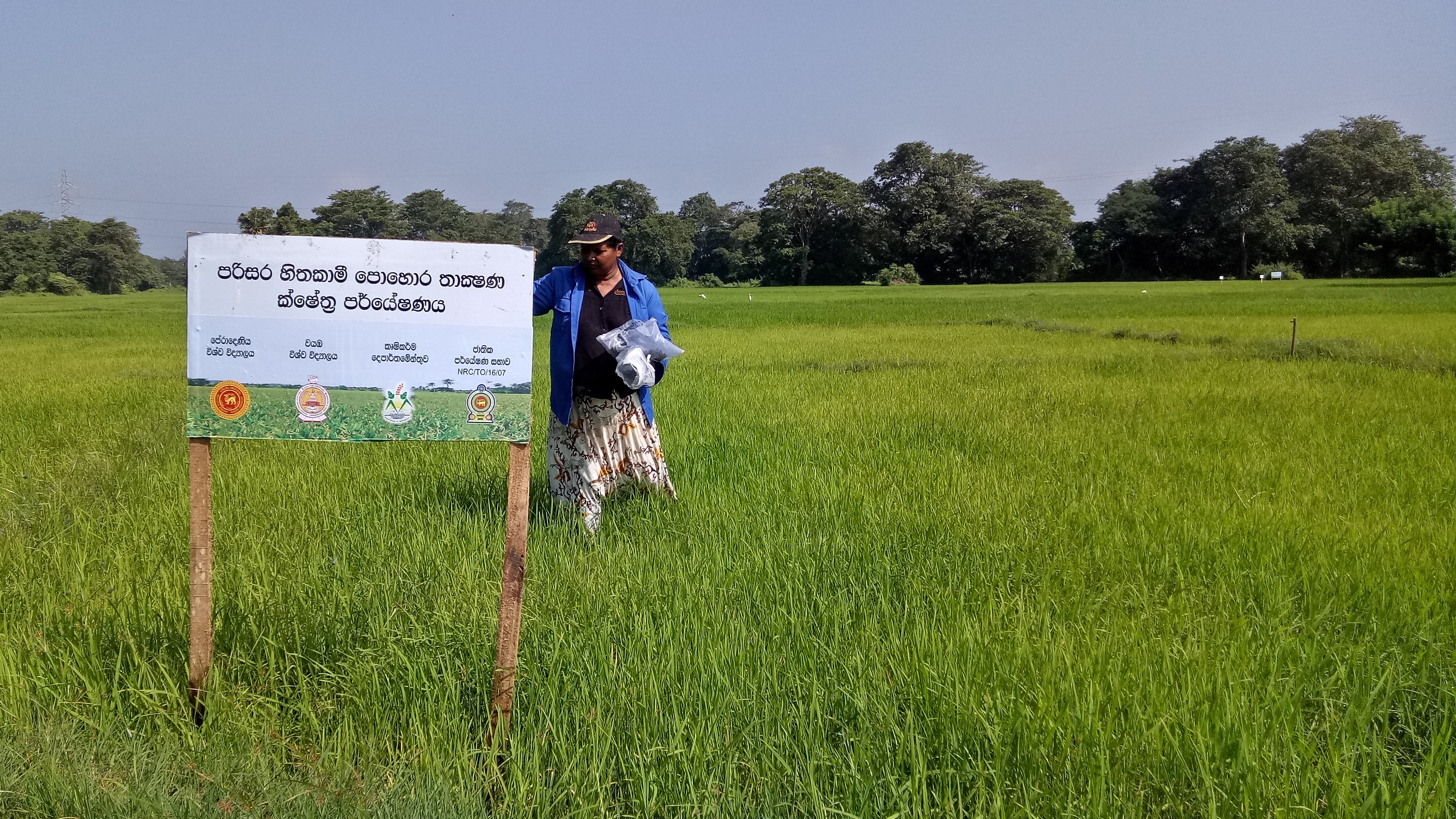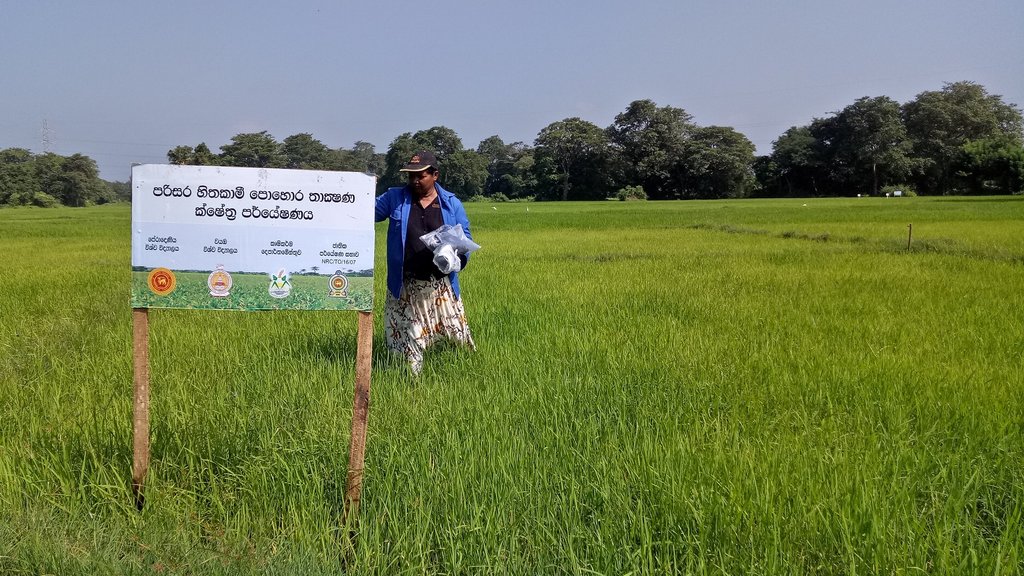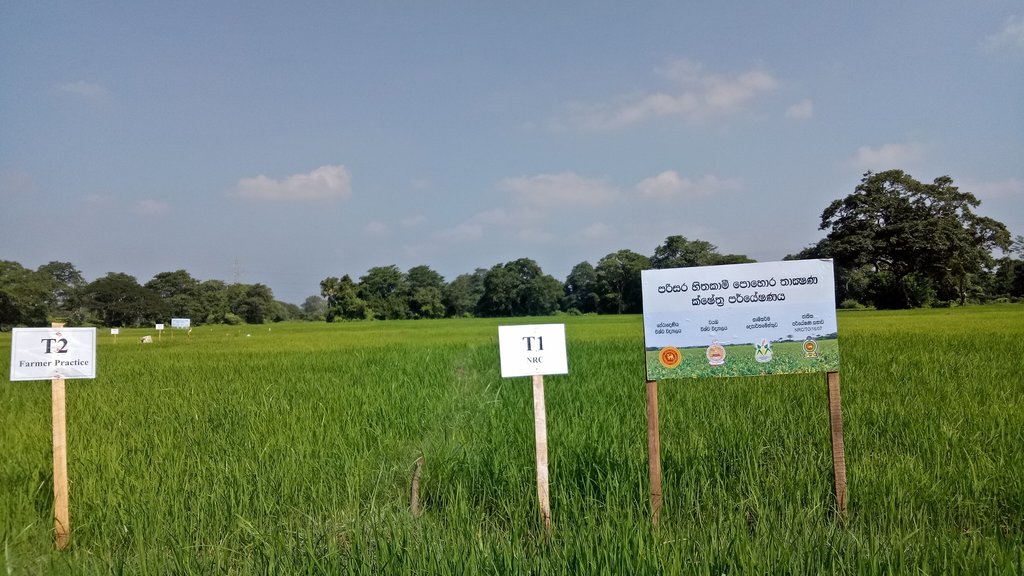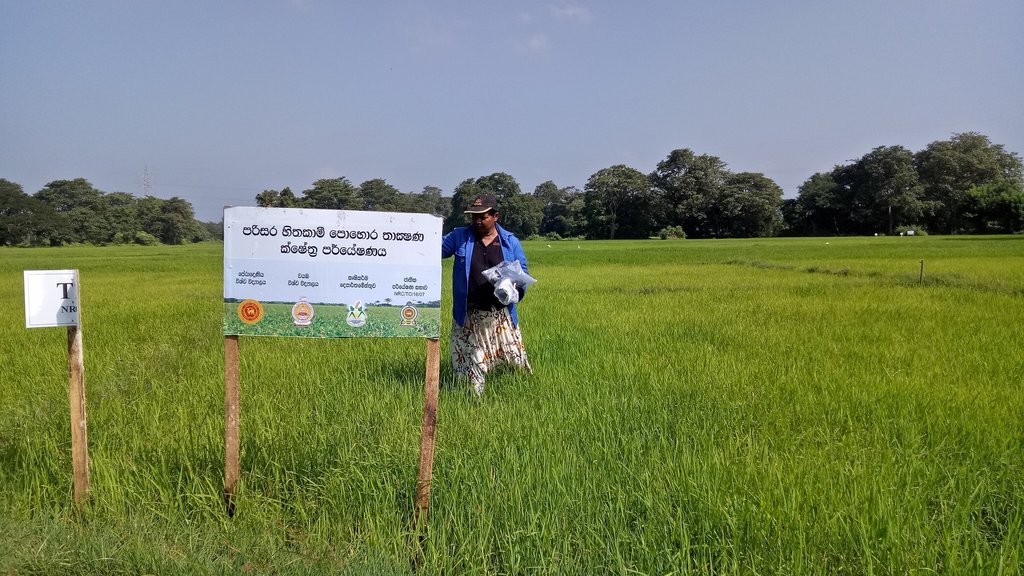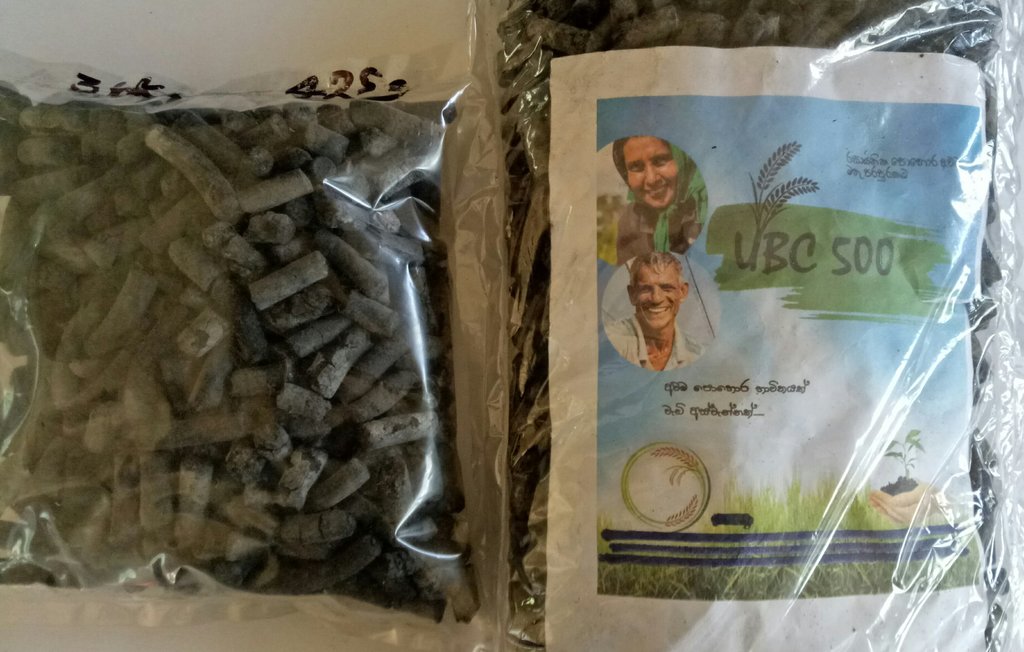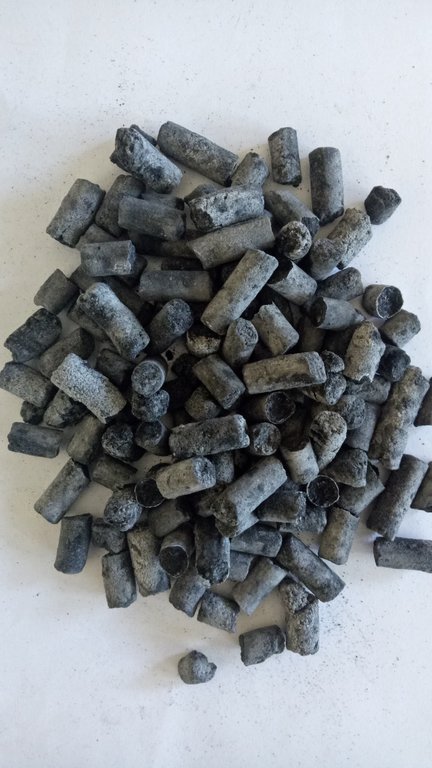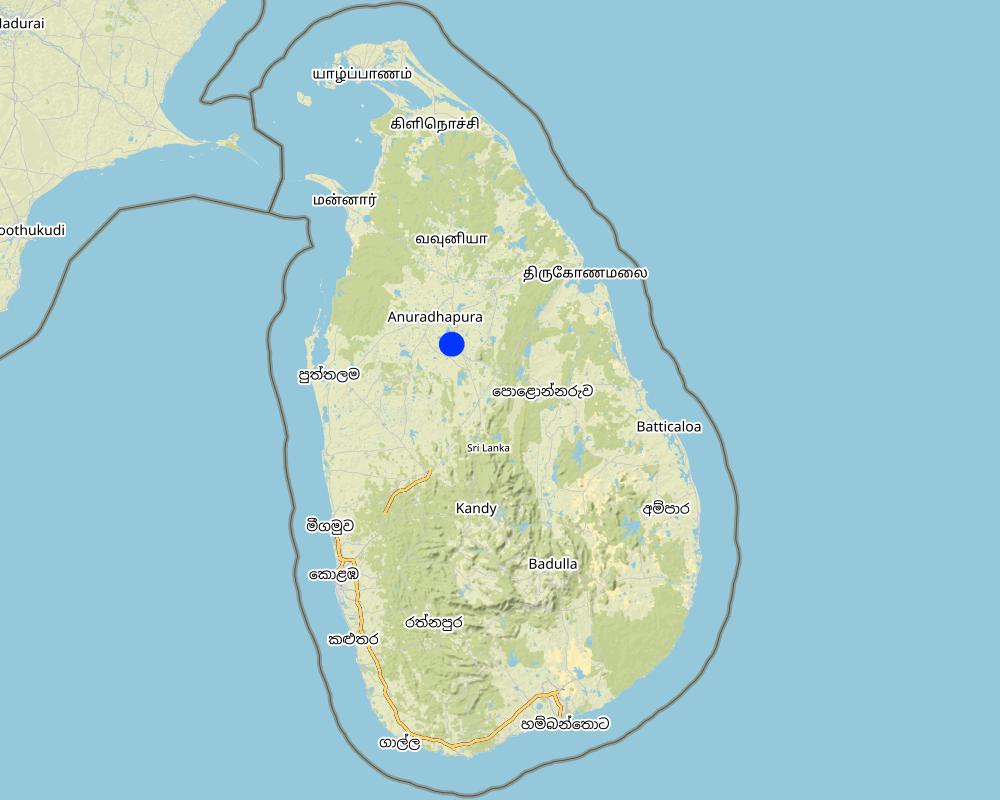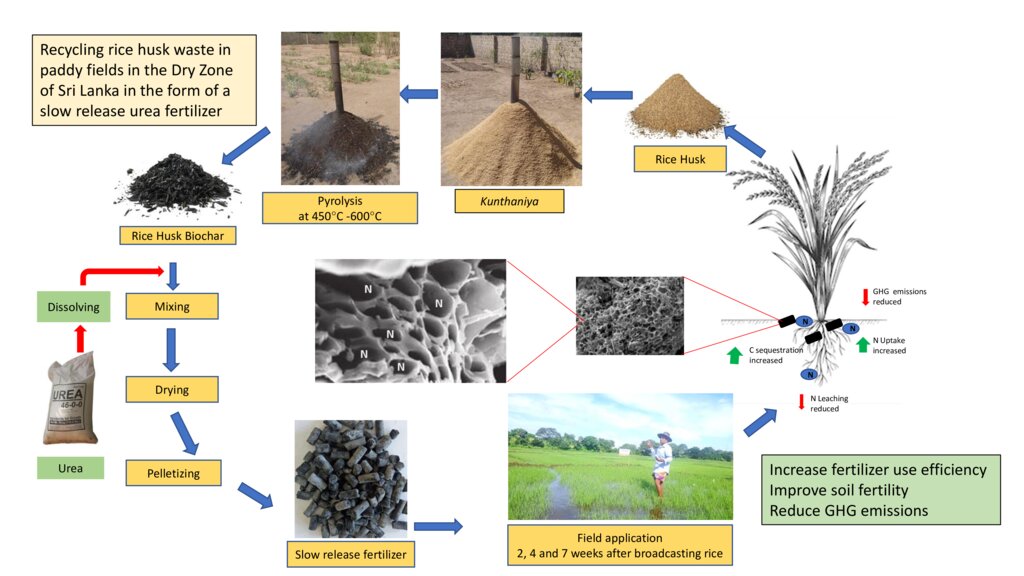Recycling rice husks in Sri Lanka as a biochar-based slow-release urea fertilizer [Шри ланка]
- Шинийг нээх:
- Шинэчлэх:
- Эмхэтгэгч: Head Soil Science
- Хянан тохиолдуулагч: –
- Хянагчид: William Critchley, Rima Mekdaschi Studer
“anguru kata” pohora
technologies_6184 - Шри ланка
Бүлгүүдийг үзэх
Бүгдийг дэлгэх Бүгдийг хаах1. Ерөнхий мэдээлэл
1.2 Технологийг үнэлэх, баримтжуулах ажилд хамаарах мэдээлэл өгсөн хүмүүс, байгууллагуудын холбоо барих мэдээлэл
Мэдээлэл өгсөн хүн (с)
ГТМ мэргэжилтэн:
Dissanayaka Lakmini
Coconut Research Institute
Шри ланка
Газар ашиглагч:
Senarathna Renuka
Шри ланка
Газар ашиглагч:
Nandasena Lekam Ralalage
Шри ланка
Газар ашиглагч:
Kirihamige Vimalawathi
Шри ланка
хамтран эмхэтгэгч:
Dharmakeerthi Saman
University of Peradeniya
Шри ланка
хамтран эмхэтгэгч:
Технологи баримтжуулах/үнэлэх ажилд дэмжлэг үзүүлсэн байгууллага(ууд)-ын нэр (шаардлагатай бол)
Faculty of Agriculture, University of Peradeniya, Sri Lanka (AGRI.PDN) - Шри ланка1.3 ВОКАТ-аар баримтжуулсан өгөгдлийг ашиглахтай холбоотой нөхцөл
Эмхэтгэгч болон гол мэдээлэгч хүн(хүмүүс) WOCAT аргачлалаар баримтжуулсан мэдээллийг ашиглахтай холбоотой нөхцлийг хүлээн зөвшөөрсөн:
Тийм
1.4 Технологи тогтвортой гэдгийг баталгаажуулах
Энэ технологийг газрын доройтлыг бууруулж, газрын тогтвортой менежментийг хангахад тохиромжтой гэж үзэж болох уу?
Үгүй
Тайлбар:
Urea is the type of nitrogen fertilizer available in Sri Lanka. Urea is readily soluble in water and hydrolyses to ammonia which in turn is converted to nitrate by microorganisms. Nitrate can be lost by leaching, volatilization, and denitrification in paddy fields. However, slow release fertilizer (SRF) releases the N in urea slowly to the soil and allows efficient uptake by the crop at the right time. Hence, it reduces the negative environmental impacts associated with N losses and also maintains adequate productivity in rice cultivation. In addition, this technology reduces CO2 emissions from rice husks to the atmosphere.
2. ГТМ Технологийн тодорхойлолт
2.1 Технологийн товч тодорхойлолт
Технологийн тодорхойлолт:
Rice husks, a waste product generated in rice mills, can release its carbon as a greenhouse gas (GHG) to the atmosphere through burning or decomposition. Converting it into biochar and intercalating (filled) with urea can produce a slow-release nitrogen (N) fertiliser that improves N-use efficiency while minimizing GHG emissions.
2.2 Технологийн дэлгэрэнгүй тодорхойлолт
Тодорхойлолт:
Rice husks are often considered as a waste, and its carbon is released to the atmosphere as carbon dioxide (CO2) which is a greenhouse gas (GHG) through either decomposition or burning as a biofuel. However, rice husks can be converted into biochar – where its carbon is stable - with a large number of micro and sub-micron size pores in a honeycomb-like structure. Rice husk biochar was produced using an improved batch pyrolizer, “Kunthaniya”, at a temperature of between 450°C and 650°C. Pore spaces in rice husk biochar can be intercalated (filled) with urea and then, slow-release fertilizer (SRF) pellets can be produced through the use of a suitable biodegradable binder. This SRF has found to be more efficient in improving the N-use efficiency, hence the urea requirement of paddy fields in Sri Lanka can be reduced by about 25%, further contributing to environment sustainability. It has been well documented that biochar can improve soil physical, chemical and biological properties in a sustainable manner. This process is a contribution to creative recycling of agricultural waste.
The SRF technology was evaluated against current farmer practice in rice cultivated area in Mahakanumulla village, Anuradhapura district, Sri Lanka. The area belongs to the Dry Zone of Sri Lanka (mean annual rainfall <1750mm). Rice is cultivated during two seasons, yala (May-September) and maha (December – February): the yala season is generally drier. Farmers rely on irrigation water supplied from a small village tank. The SRF was transported to farmers’ fields and applied at 2 weeks (@ 100 kg/ha), at 4 weeks (@ 170 kg/ha) and 7 weeks (@ 145 kg/ha) after direct seeding.
Farmers indicated that the granule size was large and light, hence they had some concerns about even distribution of fertilizer. They perceive that plants receive N slowly compared to granular urea - suggesting the slow releasing nature of the new technology. They did not observe any yield difference. Obtaining rice husks in large quantities from rice mills to produce biochar can sometimes be difficult in some areas of the country due to competition for use in the poultry industry. Some farmers may be discouraged to implement this technology due to lack of knowledge: this can be overcome through extension officers operating at field level.
This new technology qualifies as a sustainable land management practice in number of ways. First it increases N-use efficiency in paddy fields, second it reduces the urea requirement by 25% while sustaining productivity, third it recycles agricultural wastes in paddy fields, fourth, repeated application of SRF improves soil fertility through rice husk biochar, and finally it reduces GHG emissions.
2.3 Технологийн гэрэл зураг
Гэрэл зурагтай холбоотой ерөнхий тэмдэглэл:
The photos show the application of SRF on farmers fields and the physical nature of the SRF.
2.5 Энэ үнэлгээнд хамрагдсан технологийг хэрэгжүүлсэн улс орон/ бүс нутаг/ байршил
Улс:
Шри ланка
Улс/аймаг/сум:
North Central Province
Байршлын дэлгэрэнгүй тодорхойлолт:
Mahakanumulla village, Thirappane
Технологи өргөн дэлгэрсэн эсхийг тодорхойл:
- тодорхой газар хэрэгжсэн/ жижиг талбайд төвлөрсөн
Технологи(иуд) нэвтрүүлсэн талбай тусгай хамгаалалттай газар нутагт байрладаг уу?
Үгүй
Map
×2.6 Хэрэгжсэн хугацаа
Хэрэгжүүлсэн он:
2021
2.7 Технологийн танилцуулга
Технологийг хэрхэн нэвтрүүлснийг тодорхойл:
- Туршилт/судалгааны үр дүн
- Гадны төсөл/хөтөлбөрийн дэмжлэгтэйгээр
3. ГТМ технологийн ангилал
3.1 Технологийн үндсэн зорилго (ууд)
- үйлдвэрлэлийг сайжруулах
- газрын доройтлыг бууруулах, сэргийлэх, нөхөн сэргээх
- уур амьсгалын өөрчлөлт, түүний үр нөлөөг багасгах
- үр ашигтай эдийн засгийн нөлөөг бий болгох
- нийгэмд үзүүлэх үр нөлөөг бий болгох
3.2 Технологи нэвтрүүлсэн газрын одоогийн газар ашиглалтын хэлбэр(үүд)
Нэг газр нутгийн хэмжээнд хэрэгжих холимог газар ашиглалт:
Үгүй

Тариалангийн талбай
- Нэг наст үр тариа
Нэг наст үр тариа - Таримлыг тодорхойлно уу:
- үр тариа - цагаан будаа (чийгт газрын)
Тариалалтын тогтолцоо:
Чийгт газар цагаан будаа өнжөөлгүй тариалсан
Жилд ургамал ургах улирлын тоо:
- 2
Тодорхойлно уу:
yala and maha seasons
Сөөлжлөн тариалалт хийгддэг үү?
Үгүй
Таримлыг ээлжлэн тариалдаг уу?
Үгүй
3.3 Технологи хэрэгжүүлснээр газар ашиглалтад өөрчлөлт гарсан уу?
Технологи хэрэгжүүлснээр газар ашиглалтад өөрчлөлт гарсан уу?
- Үгүй (3.4 руу шилжинэ үү)
3.4 Усан хангамж
Технологи хэрэгжүүлсэн газрын усан хангамж:
- Байгалийн/усалгаатай арга хосолсон
Тайлбар:
Rice farmers in Mahakanumulla mainly depend on irrigation water supplied from a small tank located above the rice fields. However, farmers do not irrigate rice fields if they receive adequate rainfall. But, increasingly, farmers depend on irrigation water due to decreasing rainfall during the growing season.
3.5 Технологи ГТМ-ийн аль бүлэгт хамаарах вэ
- Хөрсний үржил шимийн нэгдсэн менежмент
- Хаягдлын менежмент/хаягдал усны менежмент
3.6 Технологийг бүрдүүлэх ГТМ арга хэмжээ

Агрономийн арга хэмжээ
- А2: Органик нэгдэл/ хөрсний үржил шим
- А3: Хөрсний гадаргыг сайжруулах
- А6: Хагд өвсний менежмент
А3: Хөрс боловсруулах тогтолцоог ялгана уу:
A 3.3: Full tillage (< 30% soil cover)
А6: Хагд өвсний менежментийг тодорхойлно уу:
А 6.4: хадгалсан
Тайлбар:
Application of SRF to the crop at the required growth stages to improve the soil fertility and, thus, crop productivity.
3.7 Технологид харгалзах газрын доройтлын төрөл

хөрсний химийн доройтол
- Cn: Үржил шим ба ялзмаг буурах (элэгдлийн шалтгаангүй)
- Cp: Хөрсний бохирдол

усны доройтол
- Hp: Гадаргын усны чанар муудах
- Hq: Гүний усны чанар муудах
Тайлбар:
The SRF technology improves soil fertility by reducing nitrogen (N) loss from the soil due to leaching. And it also reduces accumulation of excess N in surface and ground water bodies, preventing water pollution.
3.8 Газрын доройтлоос урьдчилан сэргийлэх, сааруулах ба нөхөн сэргээх
Газрын доройтолтой холбоотойгоор Технологи ямар зорилго тавьсан болохыг тодорхойл:
- Газрын доройтлыг бууруулах
Тайлбар:
The use of conventional N fertilizers to cultivate rice for a long period of time causes higher N losses from the soil and results a potential risk of environment pollution. Application as an SRF reduces the losses of N from the soil, increases crop nutrient uptake and increases crop productivity. The reduced losses mitigate soil fertility degradation and deterioration of water quality.
4. Техникийн нөхцөл, хэрэгжүүлсэн үйл ажиллагаа, материал ба зардал
4.1 Технологийн техник зураг
Техник тодорхойлолт (техник зургийн тайлбар):
Production of SRF: Rice husks were pyrolyzed using a locally modified “Kunthaniya” (a batch pyrolyser) to produce rice husk biochar. The temperature of the pyrolyser was around 450°C to 600°C with a heating rate of less than 20°C per hour. Pore structures were saturated using a urea solution through capillary action. The urea-intercalated rice husk biochar is then mixed with a biodegradable organic substance and pelletized using a medium scale pelletizer and dried to increase its mechanical properties such as resistance to disintegration and shear forces.
Field Experiment : Five paddy farmers were randomly selected from the command area of a small tank in the Mahakanumulla Village Tank Cascade System in the Dry Zone of Sri Lanka. The produced SRF was applied at a rate of 75% of recommended N in three split applications. Yields in SRF applied areas were compared against the current farmer practice. Experimental evidence showed that there is no yield reduction despite the reduction of nitrogen input into their fields.
Зохиогч:
H.P.G.T.N. Kulasinghe
4.2 Материал болон зардалд хамаарах ерөнхий мэдээлэл
Үнэ өртөг, оруулсан хувь нэмрийг хэрхэн тооцсоныг тодорхойл:
- Технологийн нэгж тус бүр
Талбайн хэмжээ ба нэгжийг тодорхойл:
1ha
бусад/үндэсний мөнгөн нэгж (тодорхойл):
LKR
Хэрэв боломжтой бол үндэсний валютын Америк доллартай харьцах харьцааг бичнэ үү (тухайлбал, 1 ам.дол. = 79,9 Бразил реал): 1 ам.дол. =:
275.0
Хөлсний ажилчны нэг өдрийн цалингийн хэмжээг тодорхойлно уу:
1500
4.3 Бий болгох үйл ажиллагаа
| Үйл ажиллагаа | Хугацаа (улирал) | |
|---|---|---|
| 1. | Collection of paddy husk from rice milling stations | 2 months before cultivation |
| 2. | Pyrolyzing of paddy husk using a pyrolizer or a kunthani | 6 weeks before cultivation |
| 3. | Mixing with urea, ERP and other ingredients and pelletizing | 4 weeks before cultivation |
| 4. | Drying the pellets (SRF) | 2 weeks before cultivation |
| 5. | Packing and transporting SRF to the rice fields | 1 week before cultivation |
Тайлбар:
One of the major raw materials to produce SRF is rice husks and it can be supplied from rice milling stations, generally available year-round. However, there is competition for rice husks in the market because of demand from the poultry industry. Hence, finding rice husks is sometimes difficult in some areas of the country.
4.4 Бий болгоход шаардагдсан зардал, хөрөнгийн өртөг
| Зардлын нэр, төрөл | Хэмжих нэгж | Тоо хэмжээ | Нэгжийн үнэ | Зардал бүрийн нийт өртөг | Нийт дүнгээс газар ашиглагчийн төлсөн % | |
|---|---|---|---|---|---|---|
| Хөдөлмөр эрхлэлт | Manufacturing SRF | Labour days | 2.5 | 1500.0 | 3750.0 | |
| Бордоо ба биоцид | Urea | kg | 200.0 | 270.0 | 54000.0 | |
| Барилгын материал | Binding materials 1 | kg | 10.0 | 25.0 | 250.0 | |
| Барилгын материал | Binding materials 2 | kg | 10.0 | 250.0 | 2500.0 | |
| Барилгын материал | Rice husk biochar | kg | 200.0 | 50.0 | 10000.0 | |
| Технологи бий болгох нийт үнэ өртөг | 70500.0 | |||||
| Технологи бий болгох нийт үнэ өртөг, ам.доллар | 256.36 | |||||
Хэрэв газар ашиглагч нийт зардлын 100% -иас бага хэсгийг төлсөн бол хэн голлох зардлыг гаргасан бэ:
Project funded by the National Research Council of Sri Lanka (Grant No. : NRC TO-16/07)
Тайлбар:
SRF was given to the farmer, free, for application. The cost of SRF was borne by the project funded by the National Research Council of Sri Lanka (Grant No. : NRC TO-16/07)
4.5 Арчилгаа/ урсгал үйл ажиллагаа
| Үйл ажиллагаа | Хугацаа/ давтамж | |
|---|---|---|
| 1. | Application of first dose of SRF | 2 weeks after direct seeding of rice |
| 2. | Application of second dose of SRF | 4 weeks after direct seeding of rice |
| 3. | Application of third dose of SRF | 7 weeks after direct seeding of rice |
Тайлбар:
Application of correct amount of SRF at the correct growth stage of the rice crop is important for efficient uptake of N to the crop and reduce losses.
4.6 Арчилгаа/урсгал ажилд шаардагдсан зардал, хөрөнгийн өртөг (нэг жилд)
| Зардлын нэр, төрөл | Хэмжих нэгж | Тоо хэмжээ | Нэгжийн үнэ | Зардал бүрийн нийт өртөг | Нийт дүнгээс газар ашиглагчийн төлсөн % | |
|---|---|---|---|---|---|---|
| Хөдөлмөр эрхлэлт | Labour for SRF application | Labour days | 3.0 | 1500.0 | 4500.0 | 100.0 |
| Технологийн арчилгаа/урсгал үйл ажиллагаанд шаардагдах нийт үнэ өртөг | 4500.0 | |||||
| Технологи арчилах ба урсгал ажлын нийт үнэ өртөг, ам.доллар | 16.36 | |||||
4.7 Зардалд нөлөөлж байгаа хамгийн чухал хүчин зүйл
Өртөг, зардалд нөлөөлөх гол хүчин зүйл:
Labour availability and finding raw materials are the major factors that affect the cost.
5. Байгаль ба нийгмийн нөхцөл
5.1 Уур амьсгал
Жилийн нийлбэр хур тундас
- < 250 мм
- 251-500 мм
- 501-750 мм
- 751-1,000 мм
- 1,001-1,500 мм
- 1,501-2,000 мм
- 2,001-3,000 мм
- 3,001-4,000 мм
- > 4,000 мм
Жилийн дундаж хур тунадас (хэрэв мэдэгдэж байвал), мм:
1400.00
Хур тунадасны талаархи тодорхойлолт/ тайлбар:
The Mahakanumulla area receives monsoon rainfall during two distinct seasons, namely yala (May – September) and maha (December – February), hence a bimodal rainfall pattern can be observed. The highest amount of rainfall is received during the maha season, in which most of the rainfall comes from the North-eastern monsoonal rains. Lesser rainfall is received from the South-west monsoonal rains, during the yala season. Hence prolonged dry periods are observed during the yala season. Other than that, this area receives rainfall from two inter-monsoonal rains (March-April and October-November).
Холбогдох цаг уурын станцын нэр:
Mahailuppallama, Anuradhapura
Агро-уур амьсгалын бүс
- хагас хуурай
Recorded minimum and maximum temperatures in the area are 20.8°C and 29.5°C respectively
5.2 Гадаргын хэлбэр
Дундаж налуу:
- хавтгай (0-2 %)
- бага зэрэг налуу (3-5 %)
- дунд зэрэг налуу (6-10 % )
- хэвгий (11-15 %)
- налуу (16-30 %)
- их налуу (31-60 % )
- эгц налуу (>60 %)
Гадаргын хэлбэр:
- тэгш өндөрлөг / тал
- нуруу
- уулын энгэр
- дов толгод
- бэл
- хөндий
Өндрийн бүслүүр:
- 0-100 д.т.д. м.
- 101-500 д.т.д. м.
- 501-1,000 д.т.д м.
- 1,001-1,500 д.т.д м.
- 1,501-2,000 д.т.д м.
- 2,001-2,500 д.т.д. м.
- 2,501-3,000 д.т.д. м.
- 3,001-4,000 д.т.д м.
- > 4,000 д.т.д. м.
Технологи дараах асуудалд хандсан эсэхийг тодорхойл:
- хамааралгүй
Гадаргын талаархи тодорхойлолт ба бусад тайлбар:
The altitude of the area is 112m. An undulating pattern of topography is a distinct feature of this landscape. The rice is cultivated mainly in the valley area of the catena and other upland crops are cultivated in the crest area of the catena.
5.3 Хөрс
Хөрсний дундаж зузаан:
- маш нимгэн (0-20 см)
- нимгэн (21-50 см)
- дунд зэрэг зузаан (51-80 см)
- зузаан (81-120 cм)
- маш зузаан (>120 cм)
Хөрсний бүтэц (өнгөн хөрс):
- бүдүүн/ хөнгөн (элсэрхэг)
Хөрсний бүтэц (>20 см-ээс доош):
- дундаж (элсэнцэр, шавранцар)
Өнгөн хөрсөнд агуулагдах ялзмаг:
- дунд (1-3 % )
Боломжтой бол хөрсний бүрэн тодорхойлолт, боломжит мэдээллийг өгнө үү, жишээ нь хөрсний төрөл, хөрсний урвалын орчин/хүчиллэг байдал, катион солилцох чадавхи, азотын хэмжээ, давсжилт г.м.
Rice growing soils of the Mahakanumulla area are classified as Alfisols (Typic endoaquaalf). The soil is poorly drained. The pH of the soil is in the neutral range (6.05-7.23). Soil EC (55.5-143.0 µs/cm, 1:2.5 soil:water) values did not show any occurrence of soil salinity. Av. P content of the soil (Olsen P) was low for rice growth (<5 mg/kg) and ranged from 2.9-3.5 mg/kg. Av. K content of the soils was medium to high for rice growth and ranged from 61.3-99 mg/kg.
5.4 Усны хүртээмж ба чанар
Гүний усны түвшин:
< 5 м
Гадаргын усны хүртээмж:
сайн
Усны чанар (цэвэршүүлээгүй):
зөвхөн газар тариалангийн зориулалтаар ашиглах (усалгаа)
Усны чанар гэж:
гадаргын ба газрын доорхи ус
Усны давсжилтын асуудал бий юу?
Үгүй
Энэ газар үерт автдаг уу?
Үгүй
Усны чанар, нөөцийн талаархи тайлбар ба бусад тодорхойлолт:
The amount of water supplied through the irrigation is limited during the dry season (yala). The water quality is affected by soil macro-nutrients (N, P, K) added as fertilizers to the soil. Due to the undulating topography of the landscape, those soil nutrients can wash-off from higher positions to lower positions due to surface runoff and leaching into the ground water and accumulating in the water bodies in the lower positions of the catena.
5.5 Биологийн олон янз байдал
Зүйлийн олон янз байдал:
- дунд зэрэг
Амьдрах орчны олон янз байдал:
- дунд зэрэг
Биологийн олон янз байдлын талаархи тайлбар ба бусад тодорхойлолт:
Number of different tree species, wild animals, birds, insects and aquatic life can be observed around Mahakanumulla village. Forest patches can be identified mostly around the small tank, and those areas are habitats for multiple wild animals and birds.
5.6 Технологи нэвтрүүлсэн газар ашиглагчдын тухай мэдээлэл
Суурьшмал эсвэл нүүдлийн:
- Суурьшмал
Үйлдвэрлэлийн системийн зах зээлийн чиг баримжаа:
- холимог (амьжиргаа ба худалдаанд)
Бусад эх үүсвэрээс олох орлого:
- Нийт орлогын 10-50 %
Чинээлэг байдлын түвшин:
- ядуу
Хувь хүн эсвэл бүлэг:
- Хувь хүн / өрх
Механикжилтын түвшин:
- гар ажил
- механикжсан / мотортой
Хүйс:
- эмэгтэй
- эрэгтэй
Газар ашиглагчийн нас:
- дунд нас
Газар ашиглагчдын бусад шинж чанарыг тодорхойл:
Most of the land users are dependent on full time rice farming. But some land users use rice farming as a secondary source of income and do other jobs in the city. Most of the younger generation in the village are migrating for jobs in the cities.
5.7 Газар ашиглагчийн технологи нэвтрүүлсэн газрын дундаж талбайн хэмжээ
- < 0.5 га
- 0.5-1 га
- 1-2 га
- 2-5 га
- 5-15 га
- 15-50 га
- 50-100 га
- 100-500 га
- 500-1,000 га
- 1,000-10,000 га
- > 10,000 га
Энэ талбай том, жижиг, дунд алинд хамаарах вэ (орон нутгийн нөхцөлд харгалзуулна уу)?
- бага-хэмжээний
Тайлбар:
Rice is cultivated over a large area. However, single farmer manage relatively small fields (0.5-1 ha or 2-5 ha). The fields managed by farmers are located adjacent to each other.
5.8 Газар эзэмшил, газар ашиглах эрх, ус ашиглах эрх
Газар өмчлөл:
- хувь хүн, өмчийн гэрчилгээтэй
Газар ашиглах эрх:
- хувь хүн
Ус ашиглах эрх:
- нэгдлийн хэлбэрээр (зохион байгуулалттай)
Газар ашиглах эрх нь уламжлалт эрхзүйн тогтолцоонд суурилсан уу?
Үгүй
5.9 Дэд бүтэц, үйлчилгээний хүртээмж
эрүүл мэнд:
- ядуу
- дунд зэргийн
- сайн
боловсрол:
- ядуу
- дунд зэргийн
- сайн
техник зөвлөгөө:
- ядуу
- дунд зэргийн
- сайн
хөдөлмөр эрхлэлт (жишээ нь, ХАА-аас өөр):
- ядуу
- дунд зэргийн
- сайн
зах зээл:
- ядуу
- дунд зэргийн
- сайн
эрчим хүчний хангамж:
- ядуу
- дунд зэргийн
- сайн
зам тээвэр:
- ядуу
- дунд зэргийн
- сайн
усан хангамж ба ариутгал:
- ядуу
- дунд зэргийн
- сайн
санхүүгийн үйлчилгээ:
- ядуу
- дунд зэргийн
- сайн
Тайлбар:
The villagers of Mahaknumulla have access for most of the resources like infrastructure and energy/electricity/fuel. But most of the villagers/landusers complain about technical assistant/support for agricultural practices, finding markets for their produce and availability of good quality drinking water. The villagers go to nearby shops to buy day-to-day needs, but they have to go to the town, which is 8-10km away, for other services such as health and financial services.
6. Үр нөлөө ба дүгнэлт
6.1 Технологийн талбайд үзүүлсэн нөлөө
Нийгэм-эдийн засгийн үр нөлөө
Үйлдвэрлэл
газар тариалангийн үйлдвэрлэл
ГТМ хэрэгжихээс өмнөх тоо хэмжээ:
6.5 t/ha (two seasons)
ГТМ хэрэгжиснээс хойшхи тоо хэмжээ:
6.9 t/ha (two seasons)
Тайлбар/ тодорхой дурьдах:
Although farmers could not observe a yield increase , experimental evidence suggests upto10% yield increase compared to farmer fertilizer management. A decrease in yield however not observed by farmers despite 25% reduction in N input. The above figures are for average of five farmers over two seasons.
үр тарианы чанар
бүтээмж буурах эрсдэл
бүтээгдэхүүний олон янз хэлбэр
үйлдвэрлэлийн газар
газрын менежмент
Усны хүртээмж ба чанар
ундны усны хүрэлцээ
ундны усны чанар
мал услах усны хүрэлцээ
мал услах усны чанар
тариалангийн усалгааны усны хүртээмж
тариалангийн усалгааны усны чанар
тариалангийн усалгааны усны хэрэгцээ
Орлого, зарлага
ХАА-н зардал
ГТМ хэрэгжихээс өмнөх тоо хэмжээ:
LKR 60,750.00/ha for urea
ГТМ хэрэгжиснээс хойшхи тоо хэмжээ:
LKR 70,500/ha for SRF
Тайлбар/ тодорхой дурьдах:
LKR 270/kg urea and LKR 167/kg of SRF. Expenses were calculated assuming all other costs are constants under two situations
тухайн аж ахуйн орлого
ГТМ хэрэгжихээс өмнөх тоо хэмжээ:
LKR 520,000/ha
ГТМ хэрэгжиснээс хойшхи тоо хэмжээ:
LKR 552,000/ha
Тайлбар/ тодорхой дурьдах:
LKR 80/kg of paddy. Average yields mentioned above was used to calculate the farm income. Therefore, farm income is expected to be increased more than the expenses in SRF applied fields.
орлогын олон янз эх үүсвэр
эдийн засгийн ялгаат байдал
ажлын хэмжээ
Тайлбар/ тодорхой дурьдах:
Although a longer time is required for SRF application because of higher bulk volume (175kg more), this application cost is negligible
Нийгэм-соёлын үр нөлөө
хүнсний аюулгүй байдал/ өөрийн хэрэгцээг хангах
Тайлбар/ тодорхой дурьдах:
Expected improvements in productivity due to SRF application could strengthen the food security
эрүүл мэндийн байдал
газар ашиглалт / усны эрх
соёлын боломжууд
амралт, рекреацийн боломжууд
олон нийтийн институц
үндэсний институц
ГТМ/ газрын доройтлын мэдлэг
Тайлбар/ тодорхой дурьдах:
Farmers gain awareness through extension programmes when implementing the SRF technology
маргааныг шийдвэрлэх
нийгэм, эдийн засгийн хувьд эмзэг бүлгийнхний нөхцөл байдал
Экологийн үр нөлөө
Усны эргэлт/ илүүдэл
усны хэмжээ
усны чанар
Тайлбар/ тодорхой дурьдах:
N accumulation in water bodies is reducing due to lower N losses of SRF
ус хураах / цуглуулах
гадаргын урсац
усны урсац
гүний усны түвшин / уст давхарга
ууршилт
Хөрс
хөрсний чийг
Тайлбар/ тодорхой дурьдах:
It is expected to have a better moisture content as a result of accumulation of biochar with repeated application of SRF
хөрсөн бүрхэвч
Тайлбар/ тодорхой дурьдах:
Experimental evidence suggests that soil cover is more with rice plants that grow better and tiller more due to better N utilization for crop growth
хөрс алдагдах
хөрс хуримтлагдах
хөрс хагарах/ хагсах
хөрс нягтрах
шимт бодисын эргэлт/ сэргэлт
ГТМ хэрэгжихээс өмнөх тоо хэмжээ:
N uptake: 167 kg of N/ha
ГТМ хэрэгжиснээс хойшхи тоо хэмжээ:
N uptake: 219 kg of N/ha
Тайлбар/ тодорхой дурьдах:
Higher uptake of N by rice plants due to SRF application, nutrient recycling is expected to be improved. The above values were obtained from 5 farmer fields in the year 2021.
давсжилт
ГТМ хэрэгжихээс өмнөх тоо хэмжээ:
Electrical Conductivity : 0.11 dS/m
ГТМ хэрэгжиснээс хойшхи тоо хэмжээ:
Electrical Conductivity : 0.09 dS/m
Тайлбар/ тодорхой дурьдах:
The above values were obtained from 5 farmer fields in the year 2021.
хөрсний органик нэгдэл/ хөрсөнд агуулагдах карбон
Тайлбар/ тодорхой дурьдах:
SRF contains biochar which is a good source to improve the soil C.
хүчиллэг байдал
ГТМ хэрэгжихээс өмнөх тоо хэмжээ:
pH : 7.42
ГТМ хэрэгжиснээс хойшхи тоо хэмжээ:
pH : 7.38
Тайлбар/ тодорхой дурьдах:
The above values were obtained from 5 farmer fields in the year 2021.
Биологийн олон янз байдал: ургамал, амьтан
Ургамалын бүрхэвч
Тайлбар/ тодорхой дурьдах:
Efficient uptake of N cause to improve the crop growth, thereby vegetation cover
газрын дээрхи / доорхи карбон
ГТМ хэрэгжихээс өмнөх тоо хэмжээ:
5.2 t/ha (straw) + 8.1 (grain)
ГТМ хэрэгжиснээс хойшхи тоо хэмжээ:
6.0 t/ha (straw) + 8.7 t/ha (grain)
Тайлбар/ тодорхой дурьдах:
Higher crop growth results higher biomass production. The above values were obtained from 5 farmer fields in the year 2021.
ургамлын төрөл, зүйл
түрэмгий, харь зүйл
амьтны төрөл, зүйл
ашигт төрөл зүйл
амьдрах орчны олон янз байдал
хортон шавж/өвчний хяналт
Уур амьсгал болон гамшгийн эрсдлийг бууруулах
үер усны нөлөө
хөрсний гулсалт/ чулуун нуранги
гангийн нөлөө
циклон, бороо, шуурганы нөлөө
нүүрстөрөгч ба хүлэмжийн хийн ялгаруулалт
түймрийн эрсдэл
салхины хурд
бичил уур амьсгал
Тайлбар/ тодорхой дурьдах:
Because of the better growth of the rice plants micro climate in the paddy fields is expected to be improved.
Талбайд илэрсэн үр нөлөөг үнэлнэ үү (хэмжилт):
Plant growth parameters and yield
6.2 Технологийн талбайн гадна үзүүлсэн үр нөлөө
Усны хүртээмж
хуурай улиралд ашиглах найдвартай, тогтвортой урсац
голын адагт үерлэх
голын адагт лаг шавар хуримтлагдах
газар доорхи ус/голын усны бохирдол
Тайлбар/ тодорхой дурьдах:
N accumulation in water bodies is expected to be reduced due to lower N losses from SRF
буферлэх / шүүлтүүрийн багтаамж
салхиар тээвэрлэгдэх хурдас
хөрш зэргэлдээ газарт учирах хохирол
нийтийн/хувийн хэвшлийн дэд бүтцэд учрах хохирол
хүлэмжийн хийн нөлөө
6.3 Технологийн уур амьсгалын өөрчлөлт, цаг агаарын гамшигт үзэгдэлд өртөх байдал ба эмзэг байдал (газар ашиглагчийн бодлоор)
Уур амьсгалын аажим өөрчлөлт
Уур амьсгалын аажим өөрчлөлт
| Улирал | Өсөх эсвэл буурах | Технологи түүний нөлөөг хэрхэн бууруулж байна? | |
|---|---|---|---|
| жилийн дундаж температур | Өсөлт | мэдэхгүй | |
| жилийн дундаж хур тундас | Бууралт | мэдэхгүй |
6.4 Өртөг ба ашгийн шинжилгээ
Бий болгох зардалтай харьцуулахад ямар ашиг өгсөн бэ (газар ашиглагчийн бодлоор)?
Богино хугацаанд эргэн төлөгдөх байдал:
нөлөө үл мэдэг
Урт хугацаанд эргэн төлөгдөх байдал:
бага зэрэг эерэг
Арчилгаа/урсгал зардалтай харьцуулахад ямар ашиг өгсөн бэ (газар ашиглагчийн бодлоор)?
Богино хугацаанд эргэн төлөгдөх байдал:
эерэг
Урт хугацаанд эргэн төлөгдөх байдал:
бага зэрэг эерэг
6.5 Технологи нэвтрүүлэлт
- жишээ/ туршилт
Боломжтой бол, тоогоор илэрхийл (өрхийн тоо эсвэл бүрхэх талбай):
5 farmers/households
6.6 Дасан зохицох
Бий болсон өөрчлөлтөд зохицуулан технологийг өөрчилсөн үү?
Үгүй
6.7 Технологийн давуу тал/боломжууд
| Газар ашиглагчдын тодорхойлсон давуу тал/боломжууд |
|---|
| This technology uses less chemical fertilizer and therefore it is good for their health and environment |
| This technology gives better crop growth and slightly higher yield |
| Biochar could improve the fertility of the soil |
| Эмхэтгэгч, бусад мэдээлэл өгсөн хүмүүсийн өнцгөөс тодорхойлсон давуу тал/боломжууд |
|---|
| SRF reduces the N losses from the soil and allows the rice crop to uptake N effectively from soil at required growth stages. Efficient N uptake promotes the crop growth and increase the productivity. |
| Reduced N losses of SRF directly influence the water quality by reducing the losses of N through surface runoff and leaching and avoid accumulation in water bodies at the lower positions of the landscape. |
| Rice husks, which is are good source of C, are utilized for SRF production; hence it promotes C sequestration as it is added back to the soil as biochar. It improves the soil organic carbon pool and promotes carbon sequestration in soil. |
| Utilizing rice husks by returning back to the rice fields is an effective solution for rice waste management. |
| If the SRF production technology can be transferred to farmers, their societies can produce the SRF by themselves from the wastes generated in small scale rice mills. |
6.8 Технологийн дутагдалтай/сул тал/аюул болон тэдгээрийг хэрхэн даван туулах арга зам
| Газар ашиглагч нарын тодорхойлсон сул тал/ дутагдал/ эрсдэл | Тэдгээрийг хэрхэн даван туулах вэ? |
|---|---|
| Additional cost despite reduced chemical fertilizer | increased crop yields can partially compensate this. They can produce their own SRF if the production technology is transferred to them |
| Uneven distribution of nitrogen in the field | Changing the water management practices that have been currently adopted by farmers |
| Эмхэтгэгч, бусад мэдээлэл өгсөн хүмүүсийн өнцгөөс тодорхойлсон сул тал/ дутагдал/ эрсдэл | Тэдгээрийг хэрхэн даван туулах вэ? |
|---|---|
| The raw materials need to be formulated accurately to get the benefits of the technology. Hence, technical knowledge and experience is required when preparing SRF. | Proper guidance and technical support from the beginning to the end of the process is essential. This can be achieved through educating and training extension officers to teach and disseminate knowledge for farmers. |
7. Ном зүй ба холбоосууд
7.1 Мэдээлэл цуглуулсан арга/эх үүсвэр
- Хээрийн уулзалт, судалгаа
More than 10 field visits
- Газар ашиглагчтай хийсэн ярилцлага
Interviewed 5 farmers
Мэдээллийг хэзээ (газар дээр нь) цуглуулсан бэ?
08/05/2021
Тайлбар:
Plant growth measurements were collected 7 weeks after broadcasting rice and yield data collected after 3 ½ months after broadcasting.
7.2 Ном, хэвлэлийн ишлэл
Гарчиг, зохиогч, он, ISBN:
Preparation of Biochar as a Soil Amendment from Rice Husk and Corn Cob by Slow Pyrolysis Process, S.T. Munasinghe, R.S. Dharmakeerthi, P. Weerasinghe and L.G.S. Madusanka, ISSN 0041-3224
Хаанаас авч болох вэ? Зардал?
Tropical Agriculturist Journal
Гарчиг, зохиогч, он, ISBN:
Changes in Structural and Chemical Properties of Rice Husk Biochar Co-pyrolysed with Eppawala Rock Phosphate under Different Temperatures, D.K.R.P.L. Dissanayake, R.S. Dharmakeerthi, A.K. Karunarathna and W.S. Dandeniya, ISSN: 2706-0233
Хаанаас авч болох вэ? Зардал?
Tropical Agricultural Research Journal
Гарчиг, зохиогч, он, ISBN:
Biochar Based Slow-Release Urea Fertilizer: Production and Assessing the Effects on Growth of Lowland Rice and Nitrogen Dynamics in an Alfisol, M.K.N.W. Jayarathna, R.S. Dharmakeerthi and W.M.U.K. Rathnayaka, ISSN: 2706-0233
Хаанаас авч болох вэ? Зардал?
Tropical Agricultural Research Journal
7.3 Холбогдох мэдээллийн интернет холбоос
Гарчиг/ тодорхойлолт:
Changes in Structural and Chemical Properties of Rice Husk Biochar Co-pyrolysed with Eppawala Rock Phosphate under Different Temperatures
URL:
http://192.248.43.153/bitstream/1/3160/2/PGIATAR_30_1_19.pdf
Гарчиг/ тодорхойлолт:
Biochar Based Slow-Release Urea Fertilizer: Production and Assessing the Effects on Growth of Lowland Rice and Nitrogen Dynamics in an Alfisol
URL:
https://tar.sljol.info/articles/abstract/10.4038/tar.v32i2.8464/
7.4 Ерөнхий мэдээлэл
The WOCAT questionnaire on SLM technologies covers all the aspects that can affect on the sustainability of natural and human environment.
Холбоос ба модулууд
Бүгдийг дэлгэх Бүгдийг хаахХолбоосууд
Холбоос байхгүй байна
Модулууд
Модуль байхгүй байна


